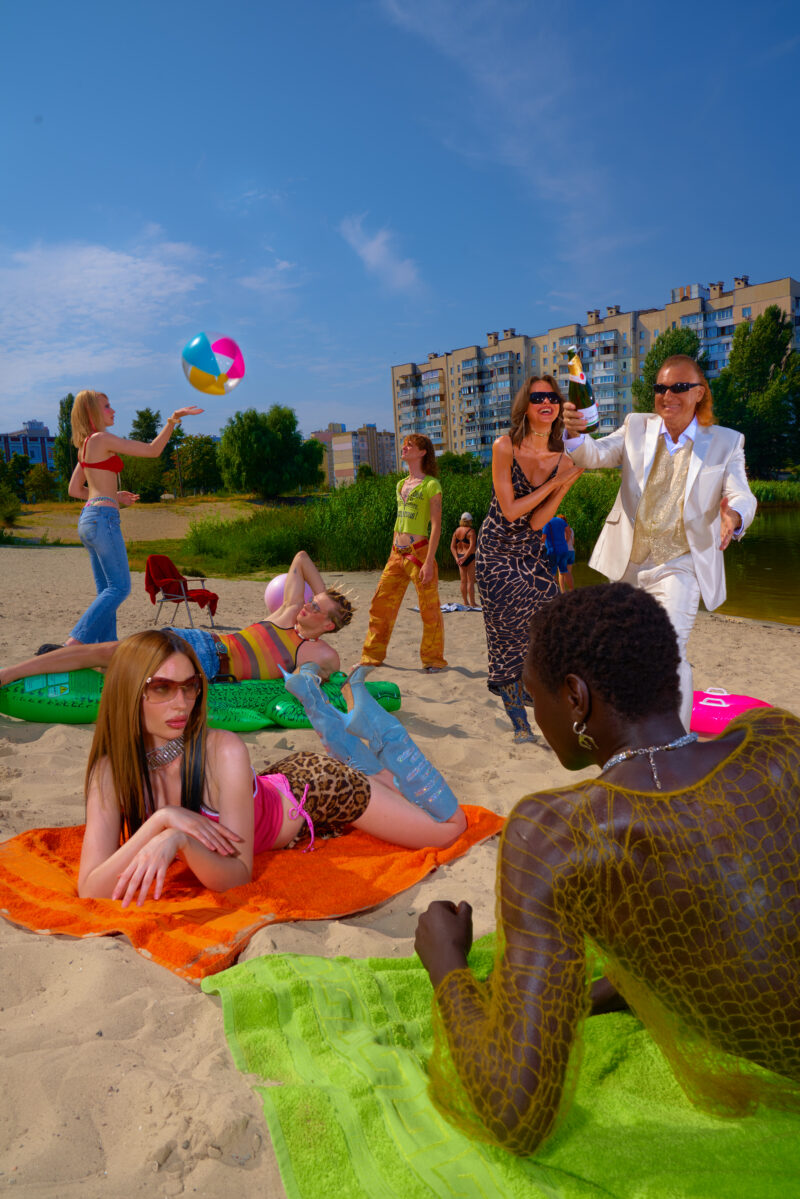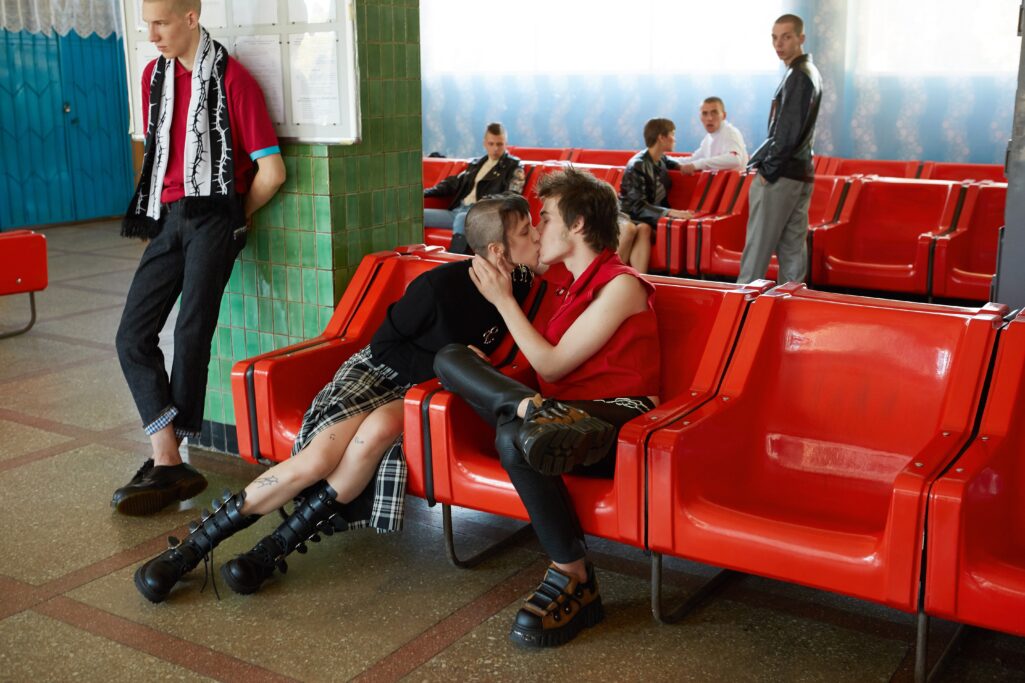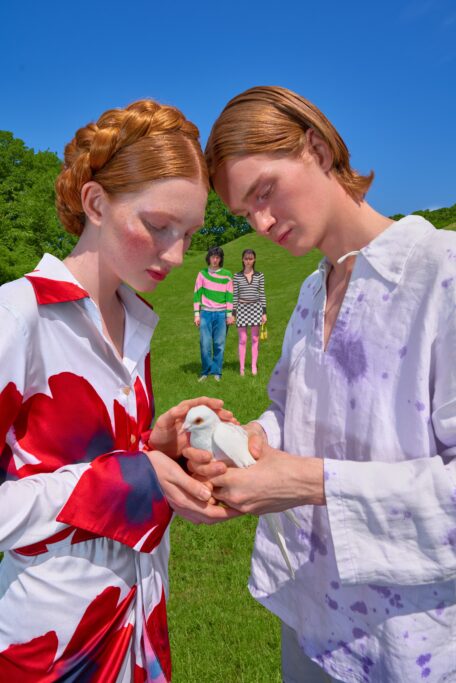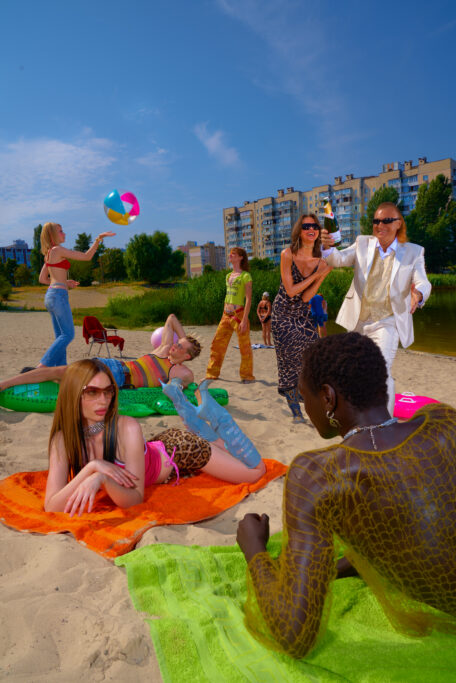4:59

Poly is one of the most renowned photographers of her generation, who reached notoriety for her provocative editorial work and her images of agitated youth, enacting worlds to come.
The exhibition title, 4:59, refers to the minute before the Russian full-scale invasion of Ukraine at 5:00 in the morning of 24 February 2022. Poly says: “To me, 4:59 is like a symbol of a time just before a traumatic event, and the importance of accessing the memories of that time.”
To Julie Poly, freedom of expression means the ability to claim one’s own future. It allows for imagining oneself as a free subject able to make autonomous decisions, independently of one’s own sexuality and provenance. Feminism and gender non-confirming perspectives are the undercurrent of her work, which strives to represent the contradictions underpinning aspirations of political liberation and raise the question of who has autonomy over the body.
In Poly’s work the way of portrayal in front of a camera—whether it be in a studio, in an interior space, or on a train—becomes part of a political and gender dissidence. Technological devices through which we extend our lives heighten the possibilities of who we can and want to be. Images are contributing to regime shifts and shape our identities.
Julie Poly was born in Stakhanov, Lugansk area in eastern Ukraine, and—until the brutal Russian invasion of Ukraine in February—she was based in Kyiv. Julie Poly’s art education started in Stakhanov, and then continued in the Kharkiv city with small groups of young artists, art initiatives, and inspiration from the Kharkiv School of Photography, and attended The Ukrainian State Academy of Railway Transport in Kharkiv. She has become internationally known through several projects, most notably ‘Ukrzaliznytsia‘ (2017–2020), which depicts life on Ukrainian trains. The project is partially staged to show the complexity of Ukrainian life across the country. Today, in a territory currently under siege, train transportation has become one of the main logistical infrastructures, allowing goods and people to continue moving internally and externally.
In close conversation, the artist and Fotogalleriet have chosen to focus on Poly’s Ukrainian production before the full scale invasion of the country to point out to a moment when life was full of hope. And although the material in the exhibition is from and references the past, it emanates Poly’s assertive vision of the future and its absurdity produced in the light of this hope. In this period, youth was central in an insurgent and irreverent approach. Yet they took to the streets for different reasons: not to protect themselves, but to show their identities freely and polymorphically. At this point in time, Julie Poly interpreted cultural and visual codes of typical Ukrainian everyday life, predominantly addressing eroticism, fashion, and novel notions of beauty. In such a search, Julie Poly found inspiration in “trivial things, everyday events, stories from friends’ lives, and experiences.” The images in the different areas of the exhibition space are produced at various moments in time, belonging to photo-shoot productions, commissions, or through the artist’s own initiative. At Fotogalleriet, they will be mixed in the exhibition space for the first time. Exploring how recollection moves and wanders, the images will be stripped of the specificity of time and place to grapple with the role of memory during situations of loss and trauma.
Poly’s interest in the crossover between documentary, fashion, and representation opens up several critical aesthetic questions and revolutions that often happen at the intersection of popular and visual culture, and outside the canonised spaces of art, such as museums and white cubes. She has challenged both worlds (consumerism and aestheticisation) to more closely approach recalcitrant modes of being by engaging with youth in practices and spaces where sexuality is being questioned and reinvented.
Following the escalation of the war, Poly’s often celebratory images have been marked by a forced shift in signification from the longing for independence they initially represented. Images which were originally intended to describe positive and conflicting values about traditions and futurity, coinciding with dissent to a patriarchal-state past and youth in rebellion. Notably, during the Soviet regime, the experimentation which took place at the Kharkiv School of Photography with depictions of the naked body, gender representation and colourisation, could easily be met with criminal charges from authorities. Today, the dreams and worlds Poly depicts and constructs have been frozen at best, possibly broken for a whole generation. Therefore, Poly’s images have also become a trace of a period of aspiring autonomy, particularly concerning feminism, gender, dissent, and non-conformance.
The exhibition 4:59 will focus on Poly’s documentary-, fashion-, and other practices of image production, aiming to mirror—like in a dream—the joyous aspects of life and desire, freedom, and the multiplicity and contradictions that communities carry. Despite the images being taken in a country currently under heavy attack and occupation, the exhibition strives to move sadness towards other emotions, supporting notions of reconstruction, and recovery, and strengthening necessary ideals of democratic principles through Poly’s multifaceted world.
Besides newly printed large-size images, never shown before in these formats, the exhibition will include an audio installation, furniture, textile and other materials to create approachable everyday environments.
On 31 January 6:00—7:30PM, the artist will be in conversation with Marta Kuzma, Professor at the Yale School of Art. The event will take place at the Academy of Fine Art, Oslo National Academy of the Arts. For more information, see the event page.
Julie Poly (real name Yulia Polyashchenko, b.1986) is originally from Stakhanov, Lugansk region, and was raised in Kharkiv, a city which has greatly influenced her practice. Poly’s artistic practice merges her previous experience in documentary and staged photography. She interprets cultural and visual codes of typical Ukrainian everyday life, predominantly in eroticism, fashion, and novel notions of beauty. Poly states that she is constantly inspired by “trivial things, everyday events, stories from friends’ lives, and own experience”. Until the Russian invasion, the artist worked and lived in Kyiv. Now she is based in Munich. Julie Poly’s art education started in Kharkiv city with small groups of young artists, art initiatives, and inspiration from the Kharkiv School of Photography. The artist took her first pictures at the “Kinnyi Market” in Kharkiv. Primarily she was interested in raw documentary photography, but in 2013 she started to work with fashion which appeals to staged pictures. As a result, Poly’s portfolio lists commissions for local fashion magazines (Vogue, L’Officiel, Harper’s Bazaar) and international art publications such as Dazed & Confused, i-D, NUMERO and Jalouse. In 2021, Julie created an erotic art zine called ‘Hrishnytsia’, where she researches and collects artists who work with erotica in Ukraine in various genres and mediums. Zin focuses on eroticism in Ukraine and its presentation in the modern world. The main characters and contributors of the publication are Ukrainian artists who raise issues of sexuality, self-discovery, gender, and intimacy within their practice.
Fotogalleriet’s principal operating support is provided by The Norwegian Royal Ministry of Culture; additional operational funding comes from the Norwegian Photographic Fund (Nofofo) and Oslo Municipality.
The exhibition is produced by Fotogalleriet with additional support from The Fritt Ord Foundation.







